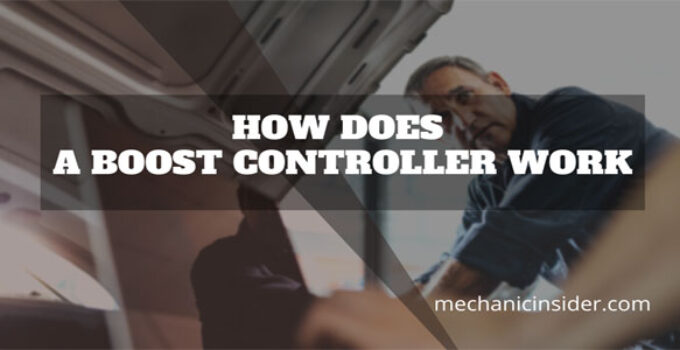Who doesn’t love to boost? More boost, more power! Yeah we get it, but how do we get it? There are tons of ways to produce more boost. But as you’re here reading how does a boost controller work, we recon you’re here to know how does it actually produces more boost, its actual functions.
The answer is simple, Boost Controller is a deceiver! Didn’t get it? You’ll get it within seconds. A boost controller actually diverts the boost pressure away from the wastegate to keep it closed for longer time allowing the turbo to make more boost.
Say you have a Watergate that allows 5-6 psi boost. Now a boost controller which is designed to divert half of the boost away from the wastegate. And then, the wastegate won’t see the mentioned psi until the turbo is actually producing almost 10-11 psi or more than its double.
So a boost controller plays the trickery part to trick the wastegate into staying closed for longer time to produce more boost. That’s it! You got your answer.
Now if you want to know the full procedure, sit back, this article will ride you the whole boost controller function thoroughly.
What is a Boost Controller?
The boost controller is a device that is commonly used in modern turbo engines that work on a pneumatic system or, boost controller can control the produced level of boost in the various turbocharged engines which deflects the boost signal that reaches the wastegate actuator.
Typically, boost is measured by psi, besides, it can also be measured by kilopascals or bars or vacuum.
The boost pressure is discerned by the wastegate which is integrated into the exhaust turbine but the wastegate is a dump to control the amount of exhaust gas from the exhaust.
So, the internal wastegate actuator is mounted on the turbo which is part of the pneumatic system, when the boost pressure increases then the pressure begins to open the wastegate via the actuator and the actuator to slow the build-up of boost until the desired level is reached.
There are mainly two types of boost controllers.
- Manual Boost Controller
- Electronic Boost Controller.
Manual Boost Controller:
Manual boost controller has another name is mechanical boost controller. The manual boost controller is an extremely simple device that is very easy to install because it can increase boost in cost-effective ways.
It usually features some form of manual adjustment; there are four components such as the body, stem, spring, and ceramic ball.
Changing the adjustment of the manual boost controller changes the amount of spring pressure exerted onto the little ceramic ball and the ceramic ball delays boost pressure from prolonging the wastegate actuator because the ball asserts more pressure than the wastegate actuator to be raised from its seat.
Electronic Boost Controller:
After knowing about the manual boost controller, the next type of boost controller is the electronic boost controller which boosts the level based on engine rpm or stationary other parameters. The electronic boost controller is pretty much a complex process and it is really expensive too.
Even though it is expensive but electronic boost controller is one of the most popular, powerful, and has a user-friendly range.
Furthermore, electronic boost controllers give the ultimate control over the boost curve with smart features designed which means you can increase the performance and response from car engines without raising the maximum boost level. It has 3 different controls over the boost curve-
- Setpoint- The maximum boot pressure.
- Gate pressure- The spool-up rate of the turbocharger.
- Sensitivity- The reaction time of the controller.
Solenoids of Electronic Boost Control:
The solenoid is a kind of valve which is simple and when the battery voltage is used for boost control, it is mechanically opened and without applying battery voltage, it turns closed. An actuator is moved that pulls open a valve because of having a magnetic field that passes through the coil by the battery voltage.
The valve is turned open and closed very fast to vary the amount of pressure bled from the hose going to the wastegate actuator.
Again, The solenoid is driven by the ECU (Engine Control Unit) and sometimes by aftermarket controllers. The ECU produces the pulsing signal and this pulsing (on and off) signal is commonly known as the wastegate duty cycle and the duty cycle means calculated the percentage of time the solenoid is open.
So, the ECU can vary this duty cycle signal to the wastegate solenoid and vary the boost higher or lower.
How Does a Boot Controller work?
Finally! We have entered the main point in this article is how does a boost controller work. If you want to understand it, the first thing is to have a look at the system components that are involved with boost control. The most obvious thing, of course, is the turbo.
Step 1:
The turbo, here exhaust going in there spinning it up, making it go faster, pumping air out of there and going in your engine making a boost.
Step 2:
Now the second thing is wastegate collectively because this is an internal wastegate, it’s split into two parts- a wastegate actuator and the other is wastegate flap. Now, let’s have a look at how the wastegate controls the boost pressure.
You have got exhausts coming from the engine going into the turbine, that’s spooling up the turbo, what the wastegate does is opens up a little flap just before the turbine to relieve the exhaust pressure.
So, it no longer spools the turbo, if once you’ve reached your peak pressure, it’s the waste gate’s job to open that flap and controller’s position so that you maintain your optimum boost pressure.
Now, the actuator’s job is actually to move the flap in the right position. This is a self-regulating kind of closed-loop system, the higher the boost pressure goes, the further the wastegate flap opens and the more it will limit the boost pressure.
So, if boost pressure goes too far, the flap opens further, and boost pressure will drop, so you will regulate pressure quite well as a system on its own.
Step 3:
you can adjust how much air bleeds out of this line which reduces the pressure to the actuator, you can also use an electronic boost controller which does a similar thing but this solenoid here is controlled by the head unit.
Now, the head unit will reference manifold pressure, and then it will make decisions about how much to bleed out of the line.
For example, you can make boosts go high, you can make it go lower and you can make it come on harder by holding the boost back from the actuator as the turbo spooling up, which will get it there faster.
So, that’s where the advantages of the electronic control come in but they’re all doing the same thing, all those controllers bleed air or prevent pressure from getting to the actuator. So, that is the fundamentals of how does a boost controller work.
Basics of Turbo , Wastegate, Solenoid :-
| Turbos | Wastegate | Solenoids |
| Turbos consist of a shaft with a turbine wheel and the wheels are compressed on each other, it uses the exhaust gas to drive a turbine and from the exhaust gas, the turbine expels energy and uses it to drive the compressor and overcome friction. | The wastegate is a valve that is used to divert excess gas away from the turbocharger when the engine produces too much boost and prevents damage to the turbine by limiting its rotational speed.
You know, the internal wastegate is split into two parts such as the wastegate actuator and the other is the wastegate flap. When the turbine relieves the exhaust pressure or reaches the peak pressure then it opens that flap and maintains your optimum boost pressure. Again, the actuator’s job is actually to move the flap in the right position. |
The solenoid is an electronic boost controller device that consists of a coil of wire and converts electrical energy into mechanical work. Thus, this electrical current flows through the wire and creates a strong magnetic field which provides the mechanical force to do work. |
Limitations of Boost Controllers:
Your boost controller whether it’s electronic or manual may not be able to fix some inherent problems with your boost control system.
For example, suppose you are trying to run 35 psi on your car and it’s not getting there or it’s tapering off towards the redline. Well, that’s not necessarily a problem with your boost controller. The limitations of any boost control system are dictated by the turbo, the engine, and the spring in the wastegate.
So, if you find that you get into the redline and your car’s boost is on the way down, it’s not because of your boost controller. It’s just that, this turbo is running out of puff.
The wastegate can’t keep shut against the exhaust backpressure and simply if you want more boost, you are going to need to change the turbo.
Verdict:
Boost controller plays pivotal role now a days. Many people are using it on full swing. Proper functioning of this tool might generate the optimum output but proportionately if not used properly, the core wastegate performance might get affected severely.



